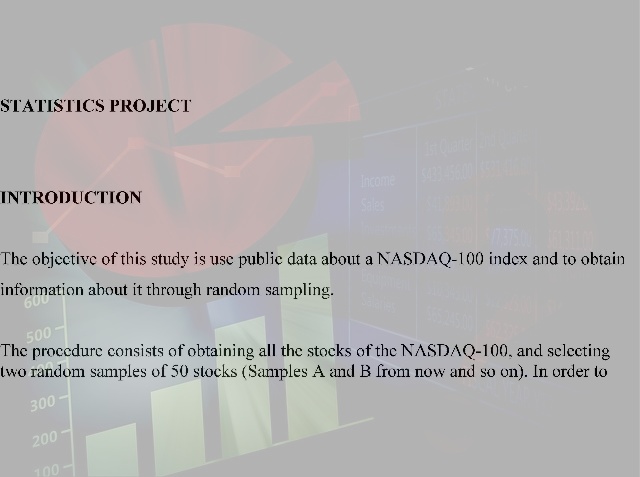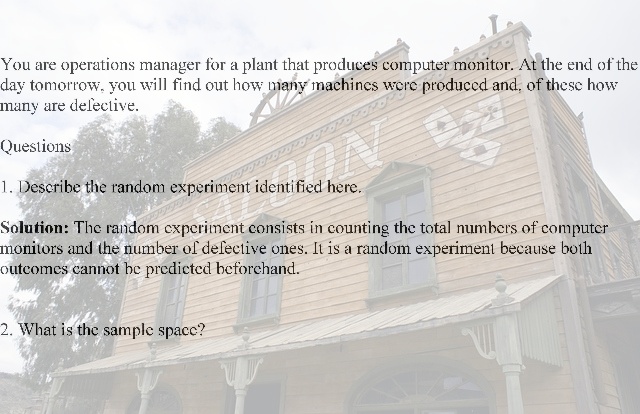(Solved) Gather a list of the names of all of the stocks that - #80217
- Gather data:
- Gather a list of the names of all of the stocks that comprise one of the following stock indinces or a stock index of your choice that has a minimum of 100 stocks.
- NASDAQ 100; USE THIS ONE GOTO http://dynamic.nasdaq.com/dynamic/nasdaq100_activity.stm
- Fortune 500;
- Fortune Global 500; or
- S&P 500 Stock Index or other S&P index of at least 100 stocks. An Excel sheet with a recent listing of the S&P 500 stocks is attached here and you may use this or one of the other lists.
- Record the current value of the index you chose; that is the value of the index itself, not each stock. You will need this information later. Also, make note of the date on which the values were recorded so that your instructor may check those values.
- Randomly choose 50 stocks from your list. Call this Sample "A" (You may use Excel to do this or you may use a random number generator, or you may use a random number table. The instructions are on page 274-279 of the text. )
- Choose a second sample (Simple Random Sample) of 50 stocks from this same list. Call this Sample "B" and some of these stocks may turn out to be the same ones that were used in Sample "A"
- For the Sample "A" and for Sample "B" chosen stocks, research the current stock price. You may get these prices from a current periodical like the Columbus Dispatch, Wall Street Journal, or USA Today. Load these prices into your Excel worksheet.
- Determine the mean and standard deviation of the sample prices of stocks.
- For the stocks in Sample "A" (only) obtain the selling price of these stock from one year ago and determine the price of the Index one year ago. You may want to use library to obtain this data. Please give dates of when the current price was taken and for when the year-prior price was taken. You may eliminate any stocks from your sample that do not have both prices available.
- Using Excel, create a histogram of the sample of the Sample "A" stocks using 8 to 12 bars. (Excel uses bins to group the data. See page 46 of your text for grouping the data and creating the histogram.)
- Using Excel, assume that the distribution of the population of all stocks on that index is normal, and using the mean and standard deviation from your sample as point estimates, find the following probabilities:
· P (a price is greater than $20)
· P (a price is less than $90)
· P (a price is between $30 and $40)
Determine the actual percentage of your sample stocks in Sample "A" that were greater than $20, less than $90, and between $30 and $40 by counting the number. Give reasons why these percentages may differ from those found in Part i above.
Using Sample "A" construct, explain and interpret a 90% confidence interval for the mean of all stocks in your index.
Using Sample "A" construct, explain and interpret a 95% confidence interval for the mean of all stocks in the index based on your sample of 50 stocks.
Conduct a test of the hypothesis that the mean price (current) of the stocks on Sample "A" is the same as the mean price (current) of all of the stocks in Sample "B." Show all five steps.
Discuss the implications of the results of this hypothesis test. In this discussion, reference the current value of each index.
Use the Sample "A" 50 stocks and the current price and the price for one year ago to conduct a paired test to determine if there has been a significant change in these stock values in the last year. Explain your results.
Write a paper including the following
An Introduction;
A detailed description of how you chose your sample;
The results of parts 1a through 1k;
A description of whether or not you believe that this population is normal and how that might affect your answers to parts i and j above; and
Your findings about the stocks. Describe what you can say about all of the stocks, including those in parts 1l through 1m above and including both the empirical and Chebyshev’s rule. Include a comparison of the percents in parts 1i and 1j.
An explanation of the confidence interval results (both 90% and 95%), and how the interval works. Include an explanation of what value change the size of the interval.
A description and explanation of the five steps in each of your hypothesis tests and an interpretation of the results of that test.
A discussion of why the sampling distribution of sample means may be assumed to be normal or not for each of the tests.
A discussion of why a paired test is appropriate in #1, part p, but not in #1, part n.
A conclusion stating what you have learned by completing this project.
Put your Excel spreadsheets (list of all stocks, index value, and the list of the 50 chosen stocks with their current price) in an appendix to the paper. Remember to document your sources.
Deliverable: Word Document
 and pdf
and pdf


![[Answer] As in the past, your homework solutions should consist - #80155 Statistics](/images/projects/project-80155/statistics-1.jpg)


